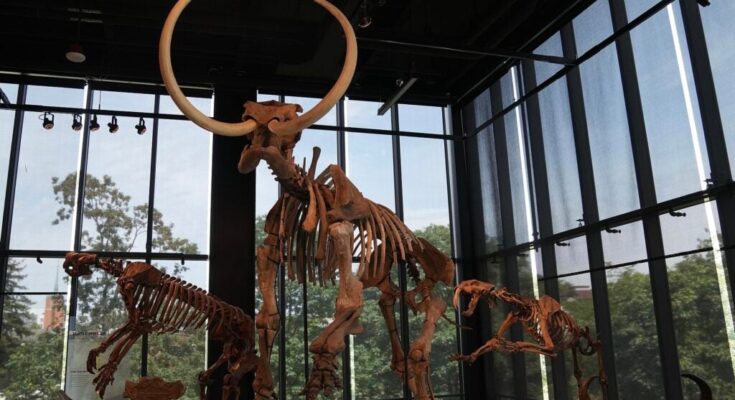When speaking of the Ice Age, it should be noted that there have been at least five ice ages in the lifetime of our planet, resulting in glacier expansion throughout Earth.
What is meant by “ice age” is prolonged periods of cold temperatures lasting for millions to tens of millions of years, leading to ice sheet and glacier coverage over large surfaces of the planet. This is also known as glaciation.
The reason the Earth is not covered by ice at the moment is because we are in a period known as an “interglacial.” In an ice age, temperatures fluctuate between colder and warmer levels. Ice sheets and glaciers melt during warmer phases called interglacials and expand during colder phases, or glacials.
The first glaciation happened about 2 billion years ago and lasted about 300 million years. The most recent one began about 2.6 million years ago, and, technically, we are still within it. Specifically, we are in a warm interglacial period that began about 11,000 years ago.
The names of these ice ages are the Huronian, Cryogenian, Andean-Saharan, late Paleozoic, and the latest Quaternary Ice Age, our own. Presently, we are in the warm interglacial period of the most recent ice age, which began about 11,000 years ago. It will take thousands of years until the Earth freezes over again.
Hence, when most people talk about the “ice age,” they are usually referring to the last glacial period, which began about 115,000 years ago and ended about 11,000 years ago with the start of the current interglacial period.
But how did our ancestors survive when the planet was covered by glaciers?
Humans on an icy Earth
There is general disagreement on when exactly humans like us, the Homo sapiens, initially appeared on Earth, with most scientists and archaeologists agreeing that homo sapiens first walked in Africa 300,000 years ago. Others place the existence of humans like us to 200,000 years ago.
Whatever the case, our early ancestors lived through a glacial period. At the beginning of the ice age, there were other species of hominins throughout Eurasia, such as the Neanderthals in Europe and the Denisovans in Asia. Both of these groups seem to have become extinct prior to the end of the ice age.
However, during the past 200,000 years, Homo sapiens have survived two ice ages. Thus, humans have withstood extreme temperature changes in the past, adopting to extremely low temperatures.
Anthropologists and archaeologists do not yet have a clear answer on how early humans adopted and survived the ice age. Earth’s climate in the period between 115,000 and 11,700 years ago, also known as the “Ice Age,” was extremely unstable. It was especially difficult for humans, animals, and plants to adapt to sudden climate shifts between warm and cold.
Recent studies show that several abrupt shifts between periods of extreme cold and dryness around 44,000 to 40,000 years ago wiped out the Neanderthals despite their abundant biological and behavioral adaptations to the cold.
During the ice age, almost all hominins disappeared. Only a single species survived—the Homo sapiens. Homo sapiens had appeared many millennia before the ice age—that is, nearly 200,000 years ago—on the continent of Africa. In many ways, it was a favorable place for our species.
Africa remained isolated from the full force of glacial activity that other hominins experienced elsewhere. The continent also had rich forests and deserts that helped make the climate more balanced and bearable.
Hence, around 70,000 to 60,000 years ago, in the middle of the ice age, the Homo sapien species began spreading across the planet for a number of possible reasons.
Survival in the ice age
With Homo sapiens having already spread throughout the world, survival was of utmost importance. Our species, along with animals such as brown bears and wolves, had to survive the cold. Large animals like mammoths went extinct during the last ice age.
So the question remains—how did our ancestors ultimately survive? In fact, it seems they were highly adaptable and, thus, not only managed to survive but also emerged as the most dominant species on the planet.
The ability to build shelter was certainly helpful. There is a common belief our ancestors lived in caves, but it is more likely they constructed stable rock shelters and covered gaps with large animal hides. Inside shelters, fires burned to keep our ancestors warm.
The importance of warm clothing was equally vital to the shelter and fire. Our ancestors had to dress warmly, and they used animal skins to do so. Anthropologist Brian M. Fagan wrote that 30,000 years ago, humans invented the most useful tool in human history: the needle. Carved from ivory, it allowed for making clothing, often sewn in layers that fit the body so as to effectively protect against the cold.
Home sapiens used the skin of reindeer, hares, and arctic foxes, and sewed this together into three or four layers. They were able to produce various types of clothing, including soft underwear and waterproof pants and parkas. For thread, they used wild flax and other vegetable fibers and made dyes from plants and berries.
Along with the needle, Homo sapiens improved existing tools, some of which had been used by Neanderthals, while also coming up with innovations in tool and weapon making. One of the most important tools created during the ice age was the burin, a type of stone chisel for creating tools such as the harpoon or spear, used in hunting.
Foraging and hunting for food was also important. Early humans gathered nuts, berries, and other plants as food. They learned the movement of herds and hunted animals in herds because that provided a reliable source of food.
Language and art
Language was likewise a vital survival tool, as Homo sapiens communicated critical information. Scientists believe that Homo erectus, an extinct early human species, may have had the ability to partake in a primitive form of conversation around two million years ago.
Language was arguably as important as anything else to ice age survival, allowing people to share knowledge, whether it was about edible plants, animal migrations, or warning about potential dangers. With the advent of language, knowledge about the natural world could be shared between neighboring bands of humans and also passed down from generation to generation via storytellers.
Through oral speech, as well as symbolic activities such as rituals, rock carving, and personal adornment, our ancestors created a shared sense of social identity and formed communities. This progressed into communities eventually expanding into even larges social units. By coming together in communities, early humans had much better survival rates against extreme ice age conditions.



